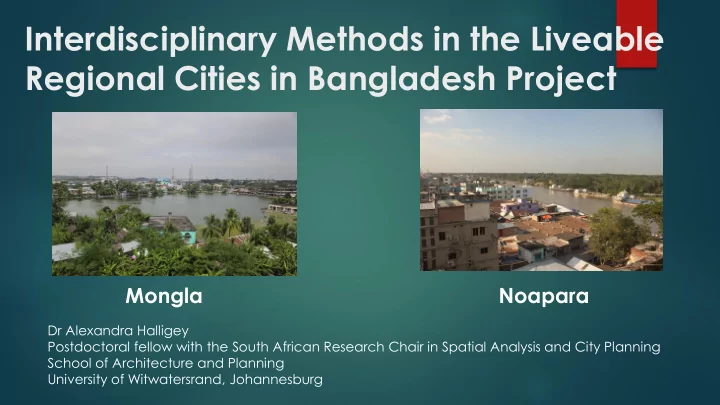

Interdisciplinary Methods in the Liveable Regional Cities in Bangladesh Project Mongla Noapara Dr Alexandra Halligey Postdoctoral fellow with the South African Research Chair in Spatial Analysis and City Planning School of Architecture and Planning University of Witwatersrand, Johannesburg
Tools we used 200 household surveys 40 semi-structured interviews 2 focus group discussions 4 storytelling workshops resulting in: 2 street theatre performances Photography and video documentation of public and private spaces Broadly we could say our tools fell into two categories: ➢ Methods conventionally used in the social sciences ➢ Methods conventionally used in arts-based research processes within the humanities
Tool 1: Household Surveys Conducted in the September of 2019 by 3 ICCCAD researchers and 3 social science students from the University of Khulna. 13 sets of questions, configured around 8 factors for liveability. The surveys were also structured containers for conversations falling outside of nominated questions and the statistical data they would produce. ➢ Many participants’ reflected to the surveyors that they had never considered the concept of liveability and what might make cities liveable or not before and that that process felt interesting and valuable to them.
Tool 2: Semi-structured Interviews and Focus Group Discussions Conducted in the last two weeks of October 2019, in the same time period as the storytelling workshops, street theatre performances and photography and film documentation. Conducted by the three Early Career Researchers running the project and ICCCAD researchers. Interview intentions: Get a sense of the context and life-world of each person o Use the 8 factors of liveability as conversation starters o Test the most common responses coming out in the survey data (at this point not o disaggregated nor analysed) Test surveyors’ impressions of each city; what we heard from other interviewees; what was o coming out of the storytelling workshops.
Tool 3: Storytelling Workshops and Street Theatre Performances Developed by Alex Halligey and co-facilitated with Bangladeshi theatre maker, Abdur Razzak. Workshop 1, day 1 - 2 to 3 hours, including lunch: Mime, tell stories with actions, act out scenes from daily life concerning: water, food, domestic o and public spaces, education and health. Open-ended games: we asked participants to work in pairs telling each other a story from their o childhood, their present life and something they would imagine for their future . We gave participants different times of day, of the week and of the year and asked them to enact something they would normally do at that time. In closing we asked everyone to name one thing they would change about their city and one thing they would keep the same . Abdur Razzak and Alex Halligey spent the afternoon weaving all the stories and images that o came up in Workshop 1 into a structure for public performance. ➢ Workshop 2 (2 hours) Showing the participants the performance structure and rehearsing it with them. o
Tool 3: Storytelling Workshops and Street Theatre Performances ➢ Street Theatre Performances (30 min) Immediately after Workshpp 2 we set out for the o chosen public space in each city and performed the work there. Razzak performed alongside the participants, playing a o narrator/chorus leader role to give a containing structure for the participants to perform within. Debrief and lunch (1 hour) ➢ We returned to the workshop venue immediately after the street o theatre performances. This final stage offered us the most valuable information as o participants’ reflected on the experience of expressing their views on liveability in the city through theatre/performance games and performing these views in public.
Tool 4: Photography and Film Took place concurrently with the semi-structured interviews, focus group discussions, storytelling workshop and street theatre performances. We worked with two filmmaker students from the Independent University of Bangladesh, one who handled photography and the other who handled film. The entire research team also acted as documenters using their smartphones to take photographs and short videos.
Tool 4: Photography and Film What was documented? Public spaces we passed through travelling between interviews and storytelling workshops. Our two visual documenters spent a couple of hours with one participant each in each city, recording their domestic surrounds and daily activities. The storytelling workshops and street theatre performances.
Video Documentary
Ethics of Engagement Our shared ethical intention as a team of interdisciplinary scholars was to collaborate with people in each city: To hear their views on what constitutes liveability for them. o How their expectations of liveability are and are not been met in o their cities. We wanted the research process to give participants voice, and for the research data and its dissemination to advocate for residents and local stakeholders to policy makers. Using mixed methods led to discussions from our relative interdisciplinary viewpoints about the ethical use of each tool and enabled an attentiveness to negotiating the ethics of engagement moment to moment in the research.
Brief summary of the value of mixed methods: Triangulated the research data, corroborating it, detailing it and productively complicating it. In a kind of shareability between methods, each one showed up data not normally associated with that method: surveys gave qualitative feels of each city, the storytelling workshops brought some ‘factual’ information to light. In a small-scale, fast-turnaround project, the mixed methods allowed for a deeper, more self-reflexive engagement than would have been possible with a single discipline’s set of tools.
Thank you South African Research Chair in Spatial Analysis and City Planning: https://www.wits.ac.za/sacp/ alexhalligey@gmail.com @alexhalligey
Recommend
More recommend